
Myrtaceae, the myrtle family, is a family of dicotyledonous plants placed within the order Myrtales. Myrtle, pōhutukawa, bay rum tree, clove, guava, acca (feijoa), allspice, and eucalyptus are some notable members of this group. All species are woody, contain essential oils, and have flower parts in multiples of four or five. The leaves are evergreen, alternate to mostly opposite, simple, and usually entire. The flowers have a base number of five petals, though in several genera, the petals are minute or absent. The stamens are usually very conspicuous, brightly coloured, and numerous.

Darwinia, sometimes commonly known as mountain bells or simply bells, is a genus of about 70 species of evergreen shrubs in the family Myrtaceae, endemic to southeastern and southwestern Australia. The majority are native to southern Western Australia, but a few species occur in South Australia, New South Wales and Victoria. The genus was named in honour of Erasmus Darwin, grandfather of Charles Darwin by Edward Rudge in 1816. Most darwinias grow to a height of between 0.2 and 3 m, and many are prostrate shrubs. Most have small, simple leaves and the flowers are often grouped together, each flower with five red, white or greenish petals and ten stamens. In many species, the flowers are surrounded by large, colourful bracts, giving rise to their common names.

Backhousia is a genus of thirteen currently known species of flowering plants in the family Myrtaceae. All the currently known species are endemic to Australia in the rainforests and seasonally dry forests of Queensland, New South Wales and Western Australia.

Baeckea is a genus of flowering plants in the myrtle family, Myrtaceae, all but one endemic to Australia. Plants in the genus Baeckea are shrubs or small trees with leaves arranged in opposite pairs, white to deep pink flowers with five sepals and five petals, and five to fifteen stamens that are shorter than the petals.
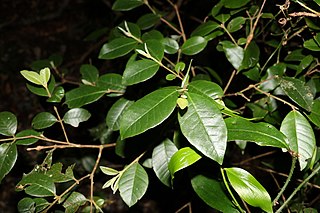
Lenwebbia is a genus of shrubs or small trees in the myrtle family Myrtaceae. The type species is Lenwebbia lasioclada.
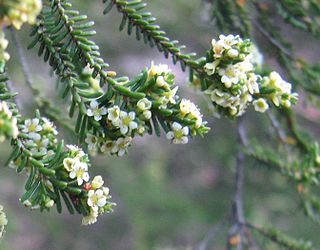
Micromyrtus is a genus of flowering plants in the family Myrtaceae and is endemic to Australia. Plants in the genus Micromyrtus are shrubs with simple leaves arranged in opposite pairs, and white, pink or yellow flowers arranged in upper leaf axils, the flowers with five sepals five petals and five or ten stamens.

Calytrix is a genus of about 83 species of flowering plants, commonly known as star flowers, in the family Myrtaceae and is endemic to Australia. Plants in the genus Calytrix are small to large shrubs with small, spreading and more or less round leaves, the flowers arranged singly in leaf axils. The flowers are bisexual with 5 overlapping sepals with a long awn, and many stamens.

Rhodomyrtus is a group of shrubs and trees in the family Myrtaceae, described as a genus in 1841 and native to southern China, the Indian subcontinent, Southeast Asia, Melanesia, and Australia.

Gossia bidwillii, known as the python tree is a rainforest myrtle of eastern Australia. The usual habitat is the drier rainforest areas. The range of natural distribution is from the Hunter River in New South Wales to Coen in far northern Queensland.
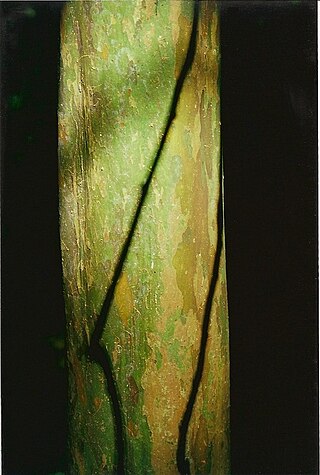
Gossia is a genus of rainforest trees in the myrtle family first described as a genus in 2003 by Neil Snow, Gordon Guymer and Sawvel. It is native to northeastern Australia as well as several islands of Papuasia and New Caledonia.
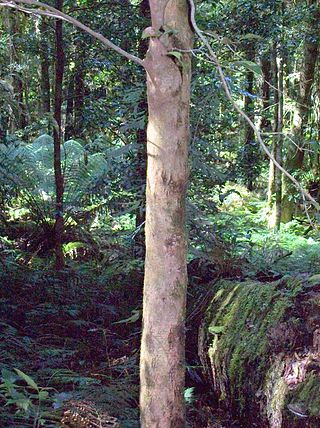
Gossia acmenoides, known as the scrub ironwood, is a rainforest tree of the family Myrtaceae, native to eastern Australia. The usual habitat of this small tree is drier rainforest areas. The range of natural distribution is from Jamberoo in New South Wales to Eungella National Park in northern Queensland.

Alangium polyosmoides is a rainforest tree of eastern Australia. It occurs on a variety of different soils, generally close to the coast. Found from Minmi near Newcastle to as far north as the McIlwraith Range in far northeastern Queensland. It may be seen as a common understorey plant at Wingham Brush Nature Reserve.

Uromyrtus lamingtonensis is a rare Australian shrub growing around the state border of New South Wales and Queensland. Like the Peach Myrtle, it has attractive pink flowers.

Rhodamnia whiteana, known as the cliff malletwood or White's malletwood is a sub-tropical rainforest plant of eastern Australia. It was first formally described in 1986 by Gordon Guymer and Laurence Jessup from a specimen collected from Mount Cordeaux.

Lithomyrtus is a genus of small trees and shrubs in the myrtle family, Myrtaceae. There are 11 species, native to the tropics of northern Australia and New Guinea:

Lithomyrtus obtusa, commonly known as beach myrtella, is a flowering plant species in the myrtle family, Myrtaceae. It occurs in coastal areas in New Guinea and Queensland, Australia.

Lithomyrtus retusa is a member of the family Myrtaceae native to Western Australia, the Northern Territory, and Queensland. It was first described in 1834 by Stephan Endlicher as Fenzlia retusa, but in 1999 it was assigned to the genus, Lithomyrtus, to give its currently accepted name, by Neil Snow and Gordon Guymer.

Gossia floribunda or Cape ironwood species of plant in the Myrtaceae family. It is a understorey plant growing to a height of 1 to 6 m. Found in Cape York Peninsula Australia and also in New Guinea. Small white flowers form in abundance.
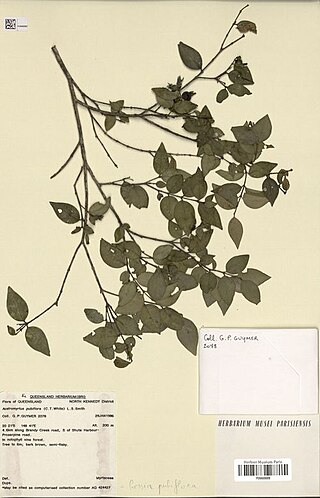
Gossia pubiflora is a species of plant in the family Myrtaceae that is endemic to coastal central east Queensland. It is a shrub or small tree that grows to a height of 1 to 6 m tall.

Gossia gonoclada, known as the square-stemmed or angle-stemmed myrtle for the distinctive four raised corners on the angled branchlets, is a rainforest tree of the family Myrtaceae, native to south-east Queensland, Australia. It is an endangered species.





















